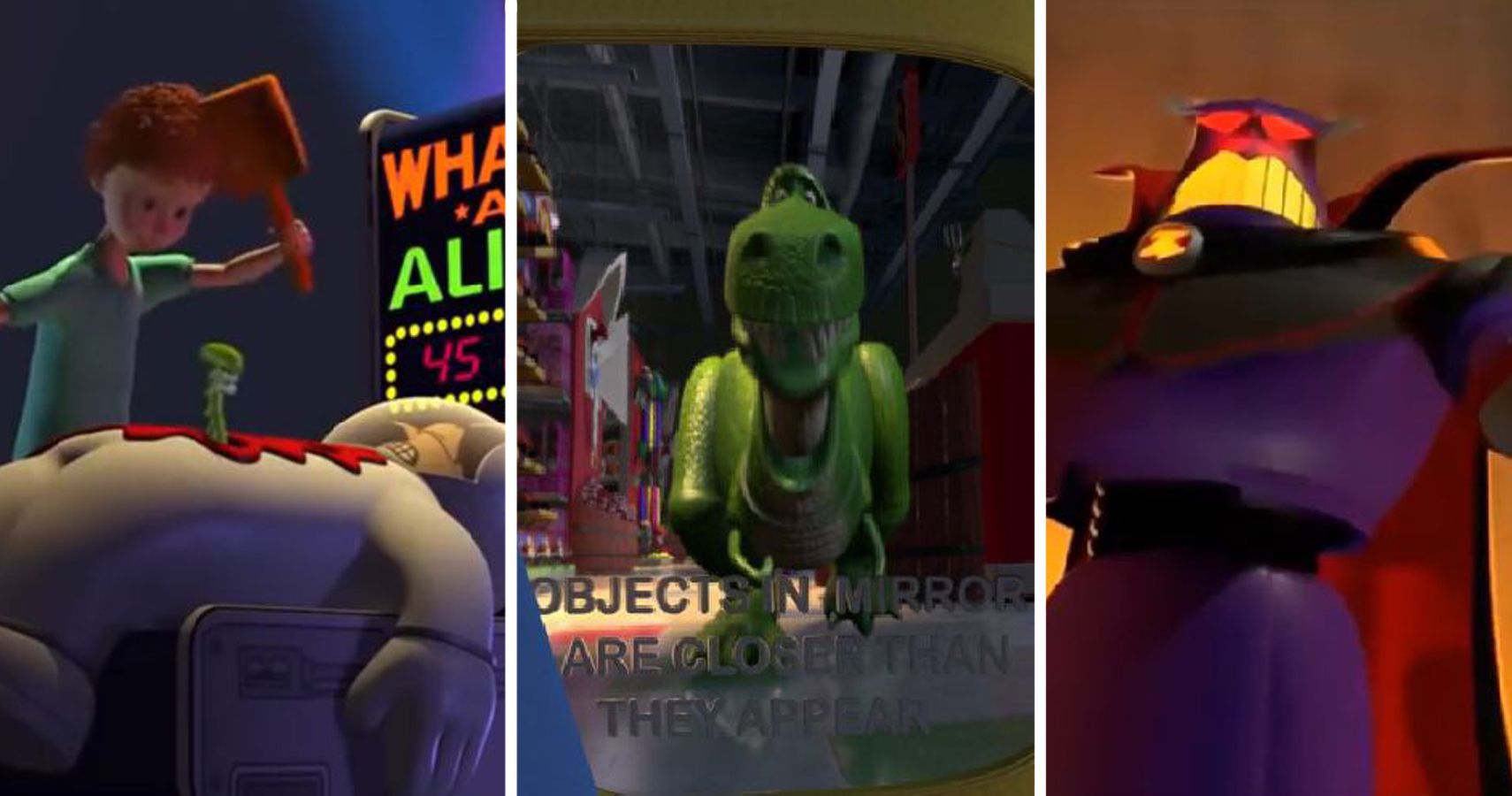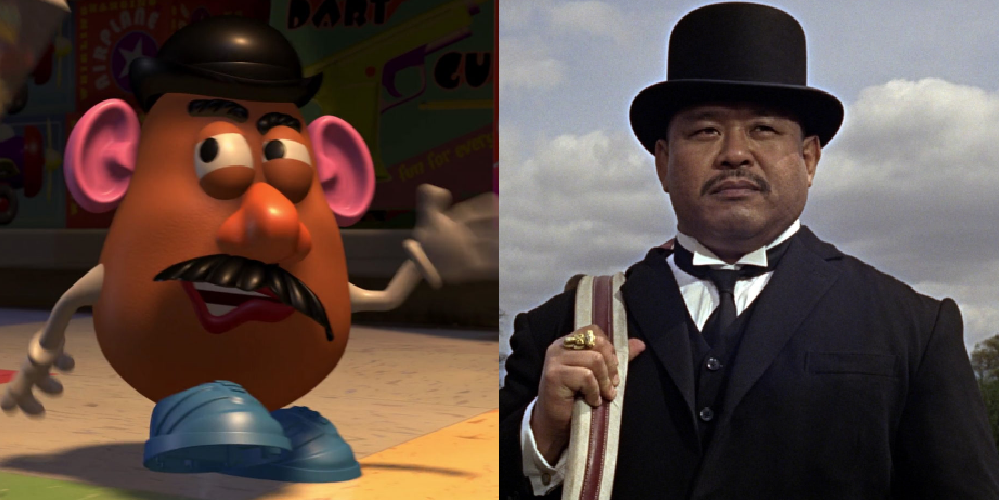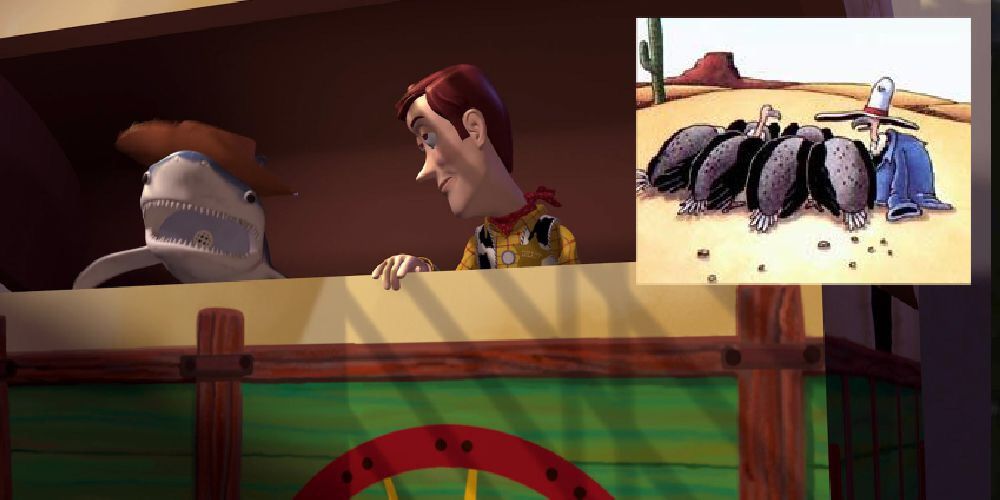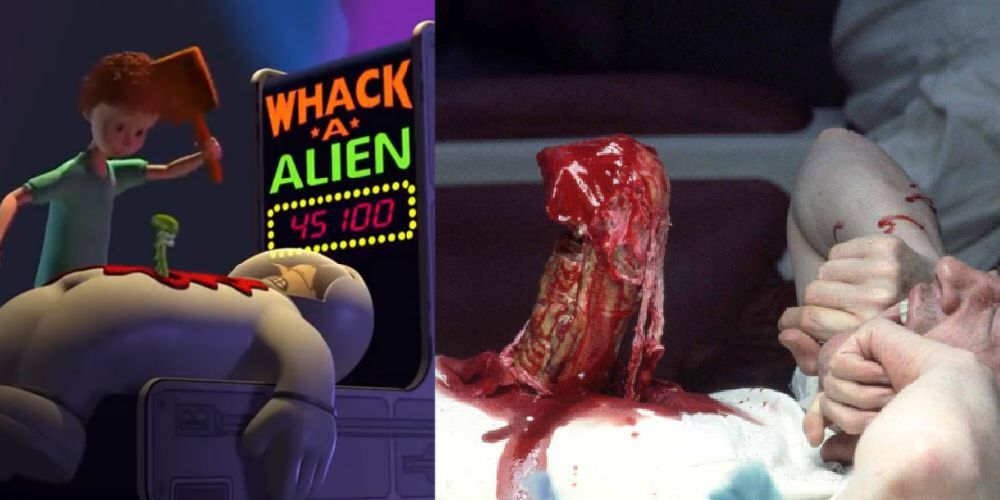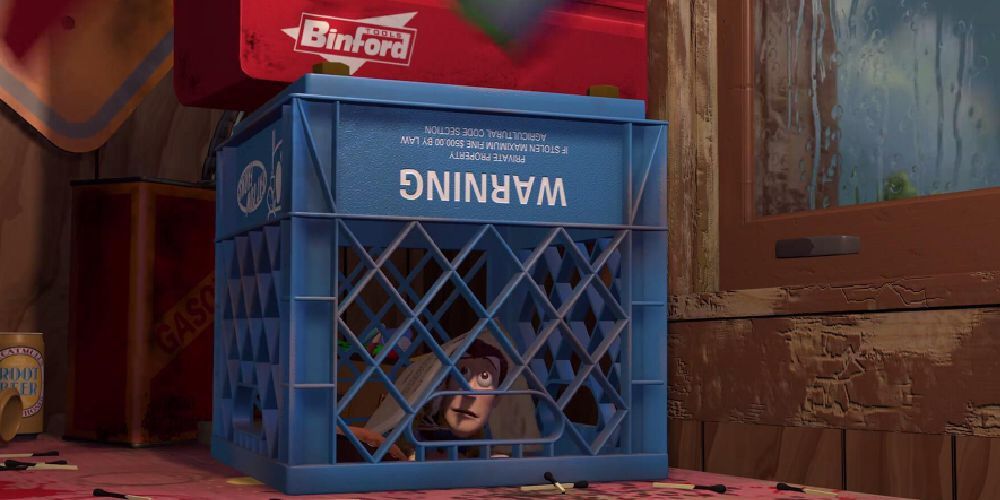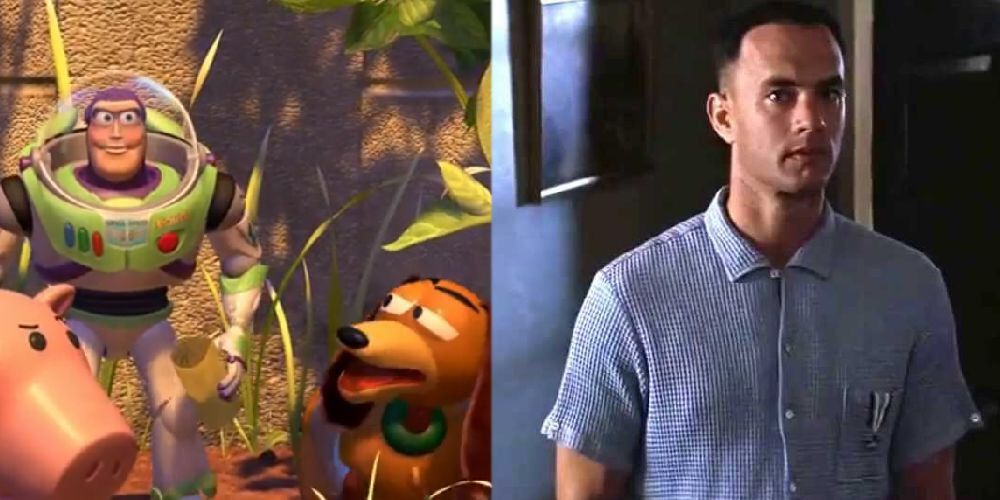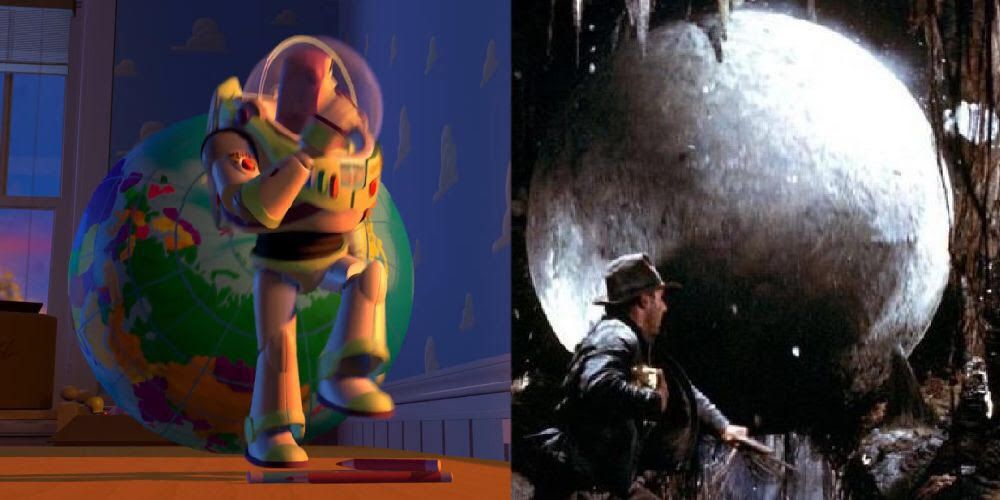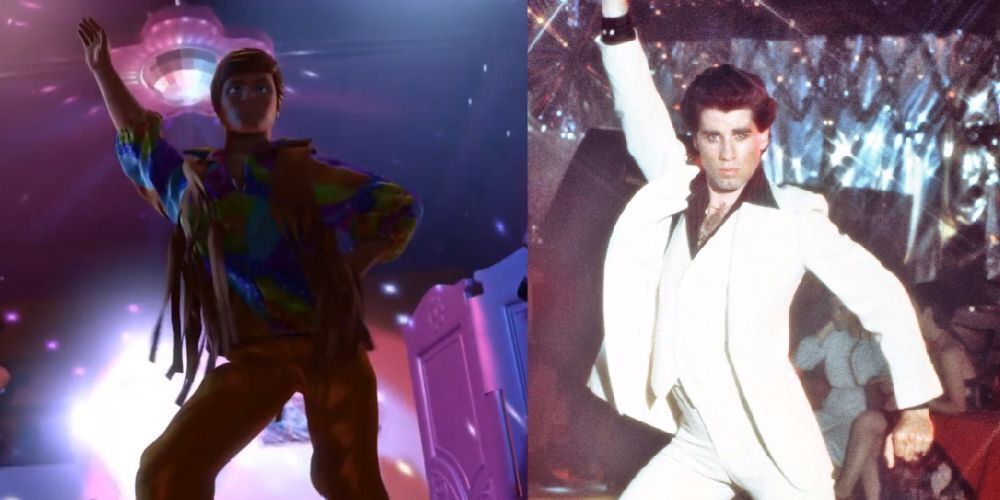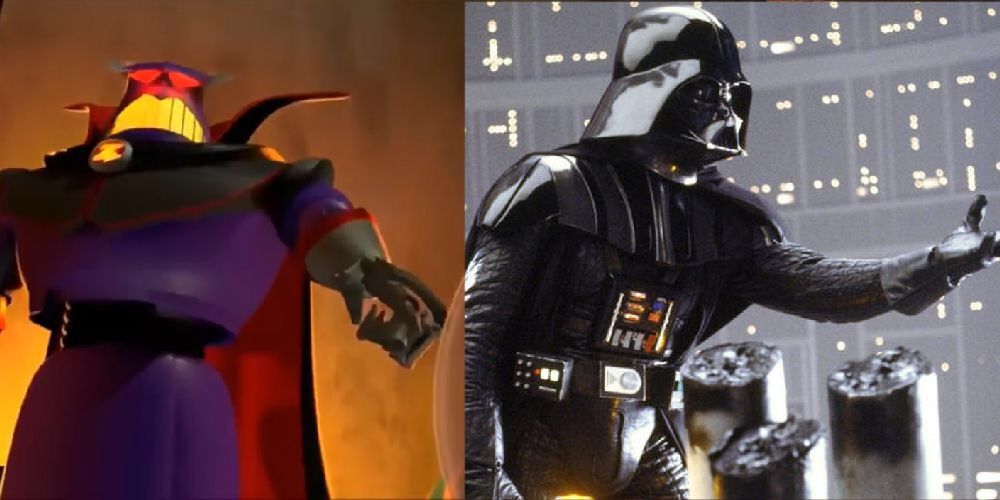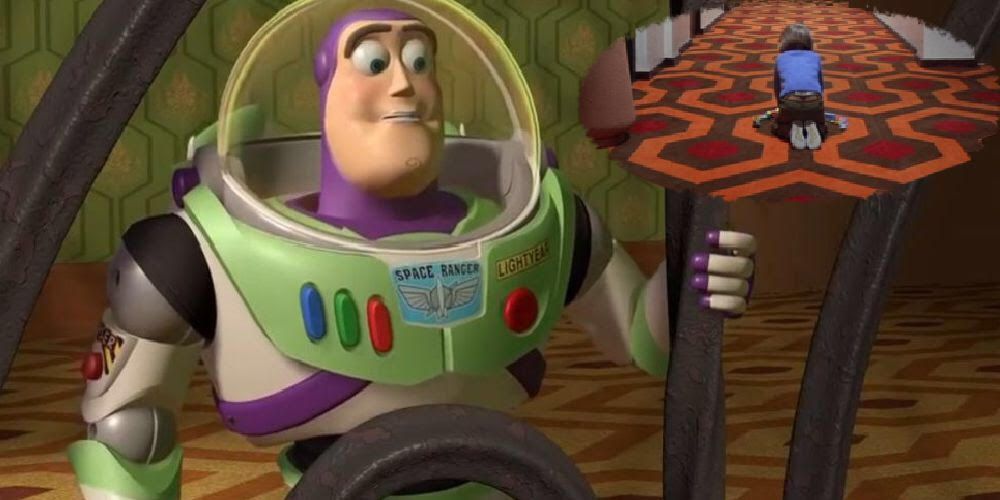The Toy Story franchise is still churning out movies nearly 25 years after the original was first released. Lending itself to the multi-genre concept of having all of these toys exist together, this means that it is drawing from a wide array of genre and reference points, some of them from popular films, television shows, and even comic strips.
From hidden nods at horror classics, to camera winks at the voice-actors' popular work, to recreations of classic films, these references help pay homage to, joke about, and riff on classic tropes, scenes, and lines. The results can be amusing, hilarious, or downright unnoticeable, and these are some of the franchise's finest moments of pop culture references.
10 10. Mr. Potato Head's Odd Headwear
If Mr. Potato Head's hat in Toy Story 2 looks familiar, it is for good reason. Based off of famed 007 villain Oddjob, the hat is used in a very similar way to the way that the diminutive henchman would have used it in Goldfinger. It is a humorous ode to such a different character than Potato Head, but it makes perfect sense given the character's bond-like set of parts.
The reference would not have only been there for the older crowd that grew up with Goldfinger. Toy Story 2's youthful audience may have also recognized the reference, as Oddjob was a coveted character in the Nintendo 64 classic, Goldeneye.
9 9. "Howdy! Howdy! Howdy!"
This is an extremely bizarre and hilarious throwaway gag during the first movie. Woody is inside a toy box looking for his hat when Mr. Shark pops out of nowhere with the hat on his head saying, "Look, I'm Woody! Howdy! Howdy! Howdy!"
If this seems bizarre and out of nowhere, then it makes perfect sense when you understand that it is a nod to Gary Larson's classic comic strip, The Far Side. The strip was known for its dark, bizarre sense of humor, and the strip which this is referencing is no exception. It shows a vulture wearing a hat and jean jacket saying nearly the exact same line.
8 8. Whack-A-Alien
It's not exactly a subtle reference, but if someone was not paying close attention, or they were too young to know about Alien, they might miss it altogether. As the characters look around the arcade at Pizza Planet, they feast their eyes upon a grammatically-frustrating game called Whack-a-Alien, where a kid is whacking aliens popping out of an astronaut's chest.
Those who have seen Alien, or at least have a passing knowledge of it, will know exactly what this is referencing. The scene is so often parodied that even some of the kids who watch the scene may catch that it is referencing something.
7 7. Sid "The Tool Man" Phillips
Savvy viewers of the first Toy Story may have noticed a meta reference to the voice of Buzz Lightyear, Tim Allen's, hit show Home Improvement when Sid captures Woody in a crate and weighs it down with a red Binford toolbox. Fans of Allen's show will recognize this as the tool brand that was constantly referenced during the fictional Tool Time.
At the time, this reference may have been far more explicit, as Home Improvement was not only still on the air, but wildly popular across the country. Now, it may hit less of the younger viewers, but it will always remain a clever nod to the time the movie was released in. It was not the only reference to one of the lead characters' other work.
6 6. Slinky Knows What Roadkill Is
In Toy Story 2, as the toys try to cross the street from Al's Toy Barn to Al's apartment complex, they must figure out how to do so without ending up in scattered pieces around the crowded intersection. Voicing his dismay, Slinky Dog (voiced by the late Jim Varney), says a line that may sound familiar to fans of Forrest Gump.
"I may not be a smart dog," he says, "but I know what roadkill is." It is a line that is too close to Tom Hanks's classic character, Forrest's: "I'm not a smart man, but I know what love is." It makes sense why they'd include this nod to what was perhaps Hanks' most iconic role at the time. It also fits the trend set out with the aforementioned Binford reference.
5 5. Buzz Goes To Indiana
The events of Toy Story are set into action when Woody sets out to push Buzz behind Woody's desk so that he can be taken to Pizza Planet instead. Amidst the elaborate and unfortunate series of events that follow, a globe falls off it and chases Buzz in an homage that any Raiders of the Lost Ark fan will immediately recognize.
Erasing any doubt of coincidence, the sound of the rolling globe is identical to the one from the scene that it is lampooning. Given another Spielberg reference, it is safe to say that the creators of Toy Story were fond of the famed director's work.
4 4. "Objects In Mirror Are Closer Than They Appear"
In another nearly direct recreation of a classic scene in cinema, Toy Story 2 finds the characters leaving Rex behind in their toy car, causing the normally friendly dinosaur to chase them down the aisle. They look into the mirror at the face of the pursuing dinosaur, and Jurassic Park fans everywhere have a field day with the reference.
The nod to Jurassic Park works on a variety of levels. Like so many other references in the films, it lends itself to the strange and different worlds of all the characters, but it also adds a healthy dose of irony. Rex's entire personality is that he is among the timidest toys throughout the franchise.
3 3. Ken Has a Fever
The relationship between Barbie and Ken in Toy Story 3 is one of the comedic highlights of the film. The materialistic mindset which would come with having a Dream House with a seemingly endless array of clothes is riffed on in a montage that is straight out of every film that deals with love between the rich and famous.
The most explicit reference in this scene, however, comes from John Travolta's classic film Saturday Night Fever, as Ken decides to show off some familiar-looking dance moves that will be very familiar to those who love the 1970's look at sex and drugs inside the New York disco scene. Here, however, it is a throwaway joke between two iconic dolls.
2 2. Buzz's Father Issues
Star Wars references have become a mainstay in canon across nearly every genre. Toy Story is littered with them throughout the franchise, but the first sequel leans most heavily on them. Beginning with the first scene, which finds Buzz on the planet Xrghthung, we see several references. There are the nods to the beginning of The Return of the Jedi, the familiar-sounding breathing inside Buzz's mask, and the overall feel of the science fiction universe they're pretending.
The references get revved up, however, as Zurg claims to be a second Buzz Lightyear's father during a fight in an elevator shaft that echos the classic showdown between Luke and Vader in The Empire Strikes Back. Here, however, it has a happy ending, as we leave the characters playing catch and doing all their father and son duties with love in their hearts.
1 1. The Entire Franchise Shines Bright
Stephen King would not be the first guess viewers would have on who is referenced most in the Toy Story movies. But references to his book, The Shining, as well as Stanley Kubrick's classic adaptation abound throughout the films thanks to editor-turned-director Lee Unkrich's fandom of King.
The first one, which makes sense when considering the setting, is the carpet at Sid's house. Eagle-eyed viewers will notice that Sid's carpet resembles the unmistakable design of the Overlook Hotel's carpet in the film. A tissue box and a security console also serve as direct designs based on the film. The infamous number 237, which is prominent in both the book and film, also pops up multiple times as an instant messenger name, a license plate number, and a camera. It is the most unlikely of references, and its subtlety and prevalence make it perhaps the most fascinating reference work in the franchise.

